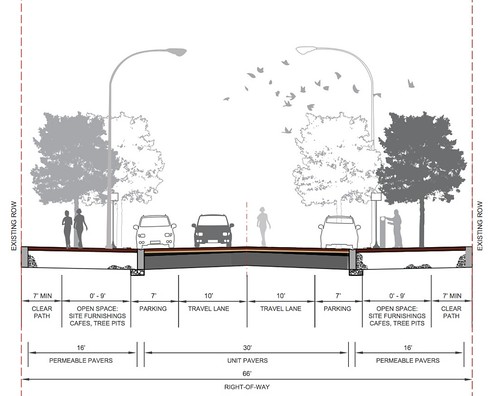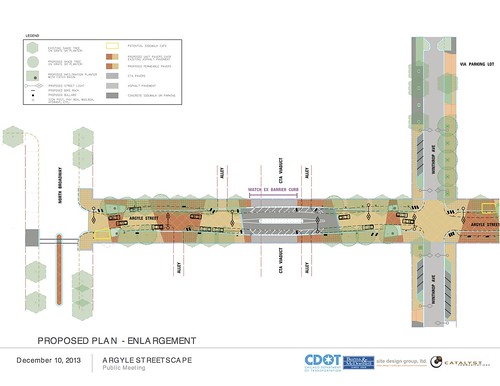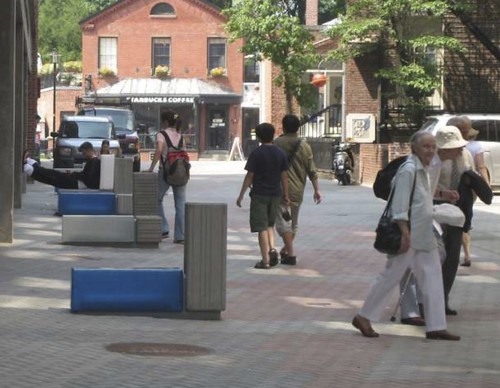The Chicago Department of Transportation is currently hashing out an ordinance to regulate how motorists will behave on the Argyle “shared street" [PDF], a pedestrian-priority zone slated for construction next year. The streetscape project -- the first of its kind in Chicago -- will create a plaza-like feel along Argyle from Broadway to Sheridan, by raising the street level and eliminating curbs. Slow motorized traffic and car parking will still be permitted on the street, but pedestrians will rule the space.
In late August, 48th Ward Alderman Harry Osterman released the final designs for the street, which will be lined with pavers from building line to building line. Two or three different colors of pavers, as well as trees and other street furniture, will be used to differentiate between travel lanes, parking lanes, and a pedestrian-only zone.
The speed limit will be lowered to 10 mph, which will allow pedestrians to safely cross the street throughout the block -- not just at crosswalks -- and make it make it comfortable for cyclists to ride in the center of the travel lanes. Other features will include wider pedestrian-only spaces to make room for outdoor cafes, plus permeable pavers, and bioswales. A colorful pillar, emblazoned with the word "Argyle," will stand in a median at the Broadway intersection, complementing the strip’s existing “Asia on Argyle” sign.
Work to replace gas and water lines on Argyle will take place in January and February, respectively, according to Osterman’s assistant Sara Dinges. The streetscape construction is scheduled to begin in April and wrap up by the end of 2015. “We want to emphasize that Argyle businesses will be open during the construction, so we want people to continue to support them,” she said.
The merchants will likely be rewarded for their patience during construction with a boost in sales after the work is finished. Studies from London found that economic activity increased on streets after shared spaces were built. Meanwhile, traffic injuries and deaths decreased by 43 percent, and drivers became 14 percent more likely to stop for pedestrians.
At a Mayor’s Pedestrian Advisory Council meeting last month, CDOT Complete Streets Director Janet Attarian noted that Chicago’s municipal code currently doesn’t allow for speed limits to be reduced below 20 mph. The code also only gives pedestrians the right-of-way within designated crosswalks on roadways.
Therefore, the department is working on an ordinance to define shared streets, designating them as locations where a lower speed limit is permissible and where drivers must stop for pedestrians anywhere along the corridor, Attarian said. Once the ordinance is drafted, Osterman will introduce it to City Council, according to Dinges.
Cambridge, Massachusetts [PDF] has built successful shared streets on Winthrop and Palmer streets, two narrow streets around historic Harvard Square. In conjunction with this, the city added language to its vehicular code mandating that that all vehicle operators, including cyclists, must yield to pedestrians on shared streets. The ordinance also states that operators must travel at a speed that ensures pedestrian safety, and that speeds over 10 mph on shared streets are “considered hazardous.”
At the MPAC meeting, Attarian said the design of the Argyle shared street will encourage all users to move at walking speed. While there won’t be won’t be stoplights or stop signs along this stretch, the border between the pedestrian-only space and the parking lane will undulate somewhat to create a gentle chicane effect. Travel lanes will be narrowed from the current 12 feet to ten feet, which will also help slow down drivers.
At the meeting, Marcia Trawinski, an advocate for seniors and people with disabilities, asked how CDOT planned to get drivers going 20-30 mph on Winthrop and Kenmore to slow down to walking speed when crossing Argyle. Attarian responded that cross traffic will have stop signs, and there will also be signs announcing that drivers are entering a shared space, as well as raised crosswalks that will calm traffic.
Complete streets advocate Daniel Ronan asked whether CDOT had done language-appropriate outreach to the local Asian-American community regarding the big changes to the business strip. Attarian said that the department and the alderman’s office have held numerous meetings with Argyle merchants, as well as public hearings in Asian establishments on the street, with good participation from people who speak English as a second language.
“We have gotten very, very positive feedback,” Attarian said. “I think the community is really engaged in the idea of how this is going to transform the street, and how they’re going to do business.”






